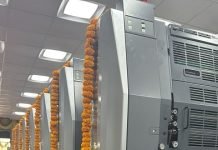
In the past year of the pandemic and the constraints of lockdowns, the packaging industry has been one of the economy’s bright spots. Packaging segments supplying to the essential commodity supply chain such as food and pharma have done exceptionally well. Flexible packaging has maintained or exceeded 2019-20 levels aided by its association with the hygienic delivery of consumer products. From June and July 2020 onwards, many blown film lines, flexo and gravure presses, and laminators were installed.
Some industry insiders have expressed apprehension about the rapid expansion of plastic-based packaging, fearing that sustainability has taken a back seat. Nevertheless, apart from the equipment installed in the past ten months, more than a dozen new film lines have been ordered from suppliers such as Bruckner and Dornier for installation in the next three years.
Corrugation has grown during the pandemic year because of the increased dependence on eCommerce during lockdowns. It is a component of the food, pharma, and consumer product supply and logistics chain. In this segment, an unprecedented number of flexo printers and box gluers have come in, as have conventional die-cutters and folder-gluers.
Experiencing low demand for commercial printing papers, some paper mills shifted to the production of recycled liner for corrugation, where demand remained healthy. The need for recycled corrugation liner led to shortages of waste paper inputs for mills and increased liner prices to corrugators.
Carton converting capacity expands more than print
The monocarton segment using paperboard has done well in food, pharma, and other segments where the supply chain includes eCommerce. The added impetus to growth has come from commercial printers who are shifting to monocarton production. While capacity building in new packaging presses was limited, there has been considerable investment in auto-platen die-cutters and folder-gluers on the converting side. In some cases, the workforce shortage with employees having gone back to their villages during the first lockdown compels a shift to automation.
However, for commercial printers shifting to cartons and for small and medium converters, high automation is too expensive. They look for appropriate automation from suppliers such as Robus India. The automation is designed locally on its die-cutters, film laminators, and folder-gluers manufactured by reputable companies in China.
Indian monocarton demands control of CAPEX
Speaking to two sets of leading monocarton manufactures recently, it emerges that except for a small niche, the bulk of the demand is for simple cartons. For commercial printers changing over to cartons, it is still essential to understand that the efficient production of even simple cartons requires investment in auto-platen die-cutters, folder gluers, film laminators, and several accessories such as gravure presses for metallics.
Another set of printers of we talked to said that even with used multicolor offset presses and converting equipment, they are competitive producers of quality cartons for local demand and exports. Despite the higher proportionate cost of raw materials, they are competitive carton exporters. The high bank interest rates in the country compel control of Capex to maintain healthy bottom lines. At the same time to maintain quality and hedge against the shortage of skilled workers, some automation is needed.
With the price realization for cartons and litho-laminated cartons in India, Capex costs have to be limited to be profitable. Commercial printers changing over to cartons, and smaller and middle-level converters cannot afford to buy new presses or highly automated converting equipment. With the volume demand for simple cartons and prices determined by reverse auction, it all comes down to controlling costs – equipment, raw materials, and overheads. Another high cost is equipment servicing and spare parts.
As Prem Vishwakarman of Robus India told us earlier in the year, “There is a change in how the converters are looking at automation. Aware that this is a period of huge growth, at the same time, they see that technology will change 180 degrees in 7 or 8 years. They are now looking for machines with the latest automation but with good local support at a lower price where they can realize their return on investment much sooner – since they may have to replace the machine in perhaps ten years or even sooner. This saving on Capex can be brought into their working capital and should have a positive effect on their balance sheets.”









